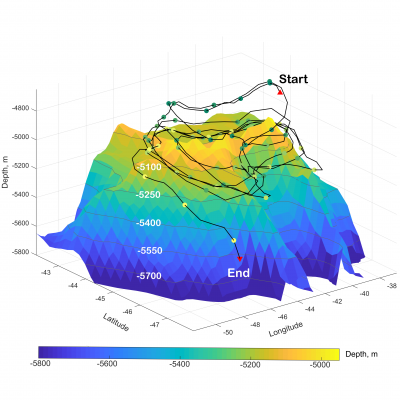Downward Spiraling Motions in the Zapiola Anticyclone
We study the pathways of water parcels that are trapped by the Zapiola Anticyclone, a strong ocean vortex in the Argentine Basin (southwest South Atlantic Ocean) that is roughly 800 km in diameter. We find that water parcels spiral downward, as they undergo downward motion while being swept around by the Zapiola Anticyclone. Water parcels can be trapped for many years, make several revolutions around the center of the vortex, descend hundreds of meters, and experience significant cooling.
The Argentine Basin is a primary conduit for water mass exchanges between the Atlantic and the Southern Ocean; North Atlantic Deep Water passes through the Argentine Basin on its way to the Southern Ocean, while Antarctic Bottom Water and Antarctic Intermediate Water make their way north. The discovery that the Zapiola Anticyclone in the Argentine Basin can trap water parcels for many years, and causes them to cool and descend by hundreds of meters, may have important implications for the water masses that pass through as part of the global thermohaline circulation.
The Zapiola Anticyclone (ZA) is a strong vortex in the center of the Argentine Basin that is tied to a bathymetric feature called the Zapiola Rise. This study investigates the kinematics of the ZA by studying the fate of the water parcels that are trapped by the ZA. We use the output from an ocean model that accurately simulates the turbulent ocean circulation in the Argentine Basin, and we use a Lagrangian approach to follow water parcels that start within the ZA. The picture that emerges is one of the water parcels spiraling downward through the water column, undergoing downwelling while they revolve counterclockwise around the center of the ZA. In our experiment, water parcels spend on average 451 days within the ZA, and make 2.6 revolutions around its center, with each revolution taking somewhere between 100 and 200 days. On average, parcels undergo a 94 m descent, 0.03°C cooling and 0.0042 psu freshening. But individual parcels can undergo more than 800 m of downwelling, 0.2°C of cooling, and ±0.02 psu of salinity change. We believe that vertical motions of this order of magnitude, and the associated water mass transformations, are unique in the abyssal mid-latitude oceans.

